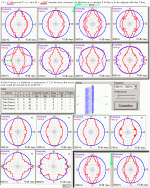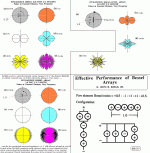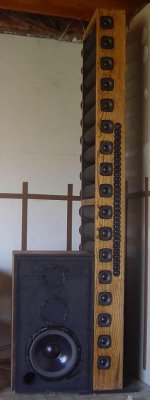Zarathu's Array is NOT BESSEL
Bessel Arrays are not the same as Griffin Nearfield Line Arrays.
This part of the discussion should be moved to a new spot where bessel arrays are discussed.
Zarathu
Bessel Arrays are not the same as Griffin Nearfield Line Arrays.
This part of the discussion should be moved to a new spot where bessel arrays are discussed.
Zarathu
Zarathu's Array is NOT BESSEL
First I want to apologize naming or referring to Bessel arrays when attempting to answer parts of Exipnos questions in post # 88 page (9).
No one has responded to that post before and sorry I missed your now # 2 post stating that this tread actually is split from another tread with HT at focus and where other types of arrays also were on topic.
As there is now no sum up or an easy to understand agenda for this tread, it still might be confusing for new readers/ attendees to know what relevant, what’s on topic for this tread and how to avoid the risk of being dismissed using the wrong words, if attending.
Bessel Arrays are not the same as Griffin Nearfield Line Arrays.
No one can deny that fact or have ever claimed something that contradict your statement on this point, here, elsewhere or in any other tread, as I can recall.
I don’t mind if most of my text and the very last of the pictures are moved, but the first sentence I wrote and the 4 following pictures should stay, as they indeed are Nearfield Line Array plots.
They are targeting Nearfield Line arrays simulated by using point sources and of using numbers found in this tread, I extrapolated from text and pictures before the thread was split.
I think the estimates are quite close, and usable as a foundation when discussing Nearfield Line Arrays especially using your approach.
Of course its my intension this should also be in agreement of what Jim Griffin really has written about crossovers and c-c distances of arrays in his paper.
If someone wants to copy yours but don’t have the knowledge necessary to read behind the lines from the texts given in this splinted piece of thread where you advocate your array dimensioning concept, I showed my alternative visual views.
I know my linguistics sucks when writing, but I think my simple pictures (and notes within) can draw attention to the parts of Nearfield line array dimensioning I find many DIY’rs fail to consider when designing with arbitrary chosen drivers.
The polar plots I modelled and submitted was an attempt to open the eyes of Exipnos or other DIY’rs, before buying this particular concept upright down, nothing more.
b
"The polar plots I modelled and submitted was an attempt to open the eyes of Exipnos or other DIY’rs, before buying this particular concept upright down, nothing more."
"Upright down" is not an American idom; must be Swedish. What does "upright down" mean?
Zarathu
"Upright down" is not an American idom; must be Swedish. What does "upright down" mean?
Zarathu
Zarathu,
Sorry for my blatant strange use of an entirely new homemade non English word used in the sentence of: ‘buying (something) uprightdown’, = a shortened reversed Sw-English form of ‘straight up and down’ for which I think when translating into the closest English expression would be:
‘Buying the concept entirely or completely ((as a whole)(immediately) without hesitating)’.
This happens all the time when I write too fast and not using my spellchecker. 😱
b
Sorry for my blatant strange use of an entirely new homemade non English word used in the sentence of: ‘buying (something) uprightdown’, = a shortened reversed Sw-English form of ‘straight up and down’ for which I think when translating into the closest English expression would be:
‘Buying the concept entirely or completely ((as a whole)(immediately) without hesitating)’.
This happens all the time when I write too fast and not using my spellchecker. 😱
b
Chugging?
B,
You mean like drinking it straight up and all the way down, without even bothering to taste it.
People sometimes do that with beer.
B,
You mean like drinking it straight up and all the way down, without even bothering to taste it.
People sometimes do that with beer.
DISTORTION IN LINE ARRAYS
Distortion measurements in line arrays have to be taken with a grain of salt.
Jim Griffin(the father of modern Near field Line Array information) describes it this way:
"Distortion tests don't reveal the true possibilities for …… tweeters used in line arrays. That is because you have power distributed to 8 or 9 [OR 20 OR 30?] devices so power distortion levels are very, very low vs. single driver measurements."
When you throw in a bi or tri amped system using electronic crossovers, even the usual crossover numbers can be misleading.
Its a shame that no one does actual distortion and FR response measurements using various line array combinations in real situations. And by this, I mean measurements that are not tied into a manufacturer selling something.
And by this, I mean measurements that are not tied into a manufacturer selling something.
I'd like to see some kind of simulation program which takes a single measurement of a tweeter, midrange or woofer, and using data, extrapolates what the FR, waterfall, and distortion measurements are likely to be when used in a line array of various number speakers. There is a baffle stop compensation program that shows the loss in using 17 mid range speakers in a line array drops to an almost insignificant <1 db.
Zarathu
Distortion measurements in line arrays have to be taken with a grain of salt.

Jim Griffin(the father of modern Near field Line Array information) describes it this way:
"Distortion tests don't reveal the true possibilities for …… tweeters used in line arrays. That is because you have power distributed to 8 or 9 [OR 20 OR 30?] devices so power distortion levels are very, very low vs. single driver measurements."
When you throw in a bi or tri amped system using electronic crossovers, even the usual crossover numbers can be misleading.
Its a shame that no one does actual distortion and FR response measurements using various line array combinations in real situations.
 And by this, I mean measurements that are not tied into a manufacturer selling something.
And by this, I mean measurements that are not tied into a manufacturer selling something.I'd like to see some kind of simulation program which takes a single measurement of a tweeter, midrange or woofer, and using data, extrapolates what the FR, waterfall, and distortion measurements are likely to be when used in a line array of various number speakers. There is a baffle stop compensation program that shows the loss in using 17 mid range speakers in a line array drops to an almost insignificant <1 db.

Zarathu
Re: Chugging?
Best thing to do with most beers brewed outside the UK or Ireland...
😉 😀
Zarathu said:You mean like drinking it straight up and all the way down, without even bothering to taste it.
People sometimes do that with beer.
Best thing to do with most beers brewed outside the UK or Ireland...
😉 😀
Attachments
Re: Re: Chugging?
You need to get off the island and over to GErmany. When I was there last year, every little nook had its own beer and they were all great. I've not spent any time in Britain since 1982, and don't remember, but would agree mostly. Certainly that would be the case for the standard beers in the USA. However, we also have a myriad of micro breweries and they are just outstanding!!
Zarathu
You need to get off the island and over to GErmany. When I was there last year, every little nook had its own beer and they were all great. I've not spent any time in Britain since 1982, and don't remember, but would agree mostly. Certainly that would be the case for the standard beers in the USA. However, we also have a myriad of micro breweries and they are just outstanding!!
Zarathu
Re: DISTORTION IN LINE ARRAYS
I would also like to see a program like this. It could sure simplify the array design process. Then again, if line arrays were simple to understand everybody would be building them.
Baffle design will be one of the next steps in my array project. Would you elaborate a bit on this program?
Thanks,
Dave
Zarathu said:...I'd like to see some kind of simulation program which takes a single measurement of a tweeter, midrange or woofer, and using data, extrapolates what the FR, waterfall, and distortion measurements are likely to be when used in a line array of various number speakers....
I would also like to see a program like this. It could sure simplify the array design process. Then again, if line arrays were simple to understand everybody would be building them.
Zarathu said:...There is a baffle stop compensation program that shows the loss in using 17 mid range speakers in a line array drops to an almost insignificant <1 db...
Baffle design will be one of the next steps in my array project. Would you elaborate a bit on this program?
Thanks,
Dave
Re: Re: DISTORTION IN LINE ARRAYS
Email me at calipso@epix.net and I'll send you the program.
Zarathu
Email me at calipso@epix.net and I'll send you the program.
Zarathu
Updated speaker choice: Midrange Choices
MADISOUND:
HP080mo at madisound 7.60 each
Hi-Vi Research B3N 3" Round Full Range, Copper Color Cone $9.55
PARTS EXPRESS:
264-809
Tang Band W3-593SF 3" Driver 8.88
HiVi A3SII Shielded Aluminum Driver Pair 4.44 ea
---------------------
ALL ELECTRONICS CORP:
http://www.allelectronics.com/cgi-bin/item/SK-480/580/4"#34;_8_OHM_SPEAKER_.html
4" 8 OHM SPEAKER
8 Ohm woofer with 10 oz magnet. Treated paper cone with rolled foam edge.
CAT# SK-480
Your Price: $5.50 each
=======
ZARATHU
MADISOUND:
HP080mo at madisound 7.60 each
Hi-Vi Research B3N 3" Round Full Range, Copper Color Cone $9.55
PARTS EXPRESS:
264-809
Tang Band W3-593SF 3" Driver 8.88
HiVi A3SII Shielded Aluminum Driver Pair 4.44 ea
---------------------
ALL ELECTRONICS CORP:
http://www.allelectronics.com/cgi-bin/item/SK-480/580/4"#34;_8_OHM_SPEAKER_.html
4" 8 OHM SPEAKER
8 Ohm woofer with 10 oz magnet. Treated paper cone with rolled foam edge.
CAT# SK-480
Your Price: $5.50 each
=======
ZARATHU
Fs: resonant frequency.
You probably know this, but just didn't register with the initials of it.
If you hit a drum, the skin vibrates (creating sound waves) at a multitude of frequencies, with the stronger vibrations defining the sound of the instrument. The cone of your driver is similar, having a frequency at which it tends to oscillate most freely. This resonant frequency is determined by the weight of the cone and the tightness of its suspension. A heavy cone and loose suspension will give the deepest bass. Fs below 20 is exceptional, with 30-40 being about average for a woofer, and Fs values around 100 or higher are common for small speakers. My 12 inch woofers have an FS of 25hz. My SAMMI midranges HAVE A Fs of 105hz. My Dayton ND20 tweeters have an Fs of 1800hz.
Most people try to avoid driving the speaker below its Fs, but in certain circumstances that's not essential. In tweeters, it is essential, and you also have to remember what your crossover slope is. In line arrays, the Fs is less important depending on the number of speakers in the line. A line of 30 ND20 tweeters is less impactive of an 1800hz Fs, than using just one or two.
The resonant frequency of the raw driver is called Fs. When the driver is put into an enclosure, the resonant frequency is raised - the new value is termed Fc.
Zarathu
You probably know this, but just didn't register with the initials of it.
If you hit a drum, the skin vibrates (creating sound waves) at a multitude of frequencies, with the stronger vibrations defining the sound of the instrument. The cone of your driver is similar, having a frequency at which it tends to oscillate most freely. This resonant frequency is determined by the weight of the cone and the tightness of its suspension. A heavy cone and loose suspension will give the deepest bass. Fs below 20 is exceptional, with 30-40 being about average for a woofer, and Fs values around 100 or higher are common for small speakers. My 12 inch woofers have an FS of 25hz. My SAMMI midranges HAVE A Fs of 105hz. My Dayton ND20 tweeters have an Fs of 1800hz.
Most people try to avoid driving the speaker below its Fs, but in certain circumstances that's not essential. In tweeters, it is essential, and you also have to remember what your crossover slope is. In line arrays, the Fs is less important depending on the number of speakers in the line. A line of 30 ND20 tweeters is less impactive of an 1800hz Fs, than using just one or two.
The resonant frequency of the raw driver is called Fs. When the driver is put into an enclosure, the resonant frequency is raised - the new value is termed Fc.
Zarathu
What is Fs of that drivers, I mean?
Frequency range they give without specifying other parameters means nothing. For example, some sellers give range 35-22,000 for speakers with 120 Hz Fs.
PS: speaking on drums, John Roberts patented, built and sells a device that help to tune drums perfectly, without that "multiple resonant frequencies" you mean. 😉
Frequency range they give without specifying other parameters means nothing. For example, some sellers give range 35-22,000 for speakers with 120 Hz Fs.
PS: speaking on drums, John Roberts patented, built and sells a device that help to tune drums perfectly, without that "multiple resonant frequencies" you mean. 😉
OK....I figured you knew what Fs means, but maybe there are some newbies here who did not and benefited by the conversation.
No clue what the Fs of the little $5.50 model is. However, having not seen one in person, and having called the company, and having them tell me that they didn't know, since all I got was the receptionist orderer person, I don't know.
They look like Sammi's except they are 4 inchers and Sammi's are 3 inchers.
If they were Sammi's then the Fs would have been 103.2
Zarathu
No clue what the Fs of the little $5.50 model is. However, having not seen one in person, and having called the company, and having them tell me that they didn't know, since all I got was the receptionist orderer person, I don't know.
They look like Sammi's except they are 4 inchers and Sammi's are 3 inchers.
If they were Sammi's then the Fs would have been 103.2
Zarathu
finding the right drivers for a calipso type design
I've come to the conclusion that people avoid the use of domes for the arrays because they are better but because they are much easier to put together. After all, wiring 60 domes and then placing them into some kind of baffle is a daunting event that took me about 5 hours. Wiring 10 ribbons could probably be done in 30 minutes.
But realistically, there are only a couple of choices in the dome arena. to avoid comb filter distortion and to keep the crossover above 2000hz you are locked into a 3/4 inch dome, and you have to have one that is a NEO magnet, since the housing has to be small enough to cut the flanges so that the c-to-c distance is less than .9 inch.
Right now the only tweeter of any quality that fits that bill is the Dayton Neo20A.
Zarathu
I've come to the conclusion that people avoid the use of domes for the arrays because they are better but because they are much easier to put together. After all, wiring 60 domes and then placing them into some kind of baffle is a daunting event that took me about 5 hours. Wiring 10 ribbons could probably be done in 30 minutes.
But realistically, there are only a couple of choices in the dome arena. to avoid comb filter distortion and to keep the crossover above 2000hz you are locked into a 3/4 inch dome, and you have to have one that is a NEO magnet, since the housing has to be small enough to cut the flanges so that the c-to-c distance is less than .9 inch.
Right now the only tweeter of any quality that fits that bill is the Dayton Neo20A.
Zarathu
I've read through this entire thread. Very Interesting 3 way array, but I don't see any pics of the setup. Could you post one to the header Eric?
I've read through this entire thread. Very Interesting 3 way array, but I don't see any pics of the setup. Could you post one to the header Eric?
I’ve attached it here.
Attachments
- Home
- Loudspeakers
- Multi-Way
- Zarathu's Line Arrays



